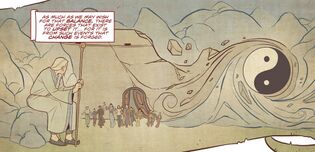Yin and yang: Difference between revisions
From Tardis Wiki, the free Doctor Who reference
(noted Bruce's definition) |
No edit summary |
||
| (4 intermediate revisions by 2 users not shown) | |||
| Line 1: | Line 1: | ||
{{Wikipediainfo}} | {{Wikipediainfo}} | ||
[[George Litefoot]] used the analogy of | {{first pic|Yin and yang.jpg|Yin and yang ([[COMIC]]: ''[[Sharper Than a Serpent's Tooth (comic story)|Sharper Than a Serpent's Tooth]]'')}} | ||
[[George Litefoot]] used the analogy of '''yin and yang''' in [[Chinese]] [[philosophy]] as a way of describing [[the Doctor]]'s [[relationship]] with [[the Valeyard]]. ([[AUDIO]]: ''[[Stage Fright (audio story)|Stage Fright]]'') | |||
[[Bruce Lee]] described yin and yang as the two sides of [[N-Space|the universe]] which "flow together in harmony". ([[COMIC]]: ''[[The White Dragon (comic story)|The White Dragon]]'') | [[Bruce Lee]] described yin and yang as the two sides of [[N-Space|the universe]] which "flow together in harmony". ([[COMIC]]: ''[[The White Dragon (comic story)|The White Dragon]]'') | ||
[[Category:Philosophy from the real world]] | [[Category:Philosophy from the real world]] | ||
Latest revision as of 16:48, 8 September 2024
George Litefoot used the analogy of yin and yang in Chinese philosophy as a way of describing the Doctor's relationship with the Valeyard. (AUDIO: Stage Fright)
Bruce Lee described yin and yang as the two sides of the universe which "flow together in harmony". (COMIC: The White Dragon)

